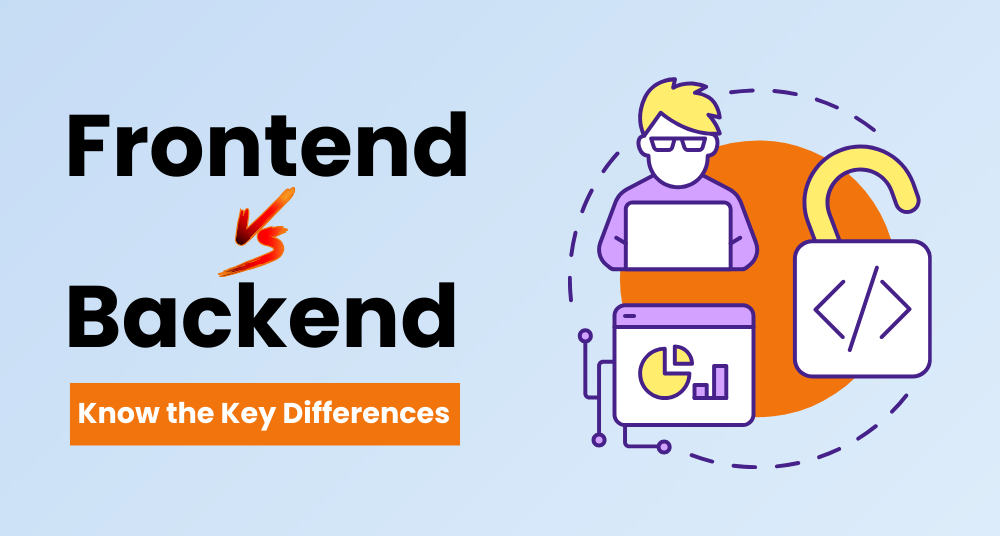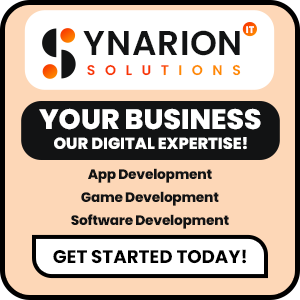In the age of rapidly evolving technology and AI, understanding web development is more important than ever. Whether you’re aspiring to be a developer or just curious about how websites and apps are built, you’ve probably come across the terms “front-end” and “back-end” development. But what exactly do these terms mean? And more importantly, which one should you focus on?
In this guide, we’ll dive deep into both aspects of web development, explain their key differences, and help you decide where to focus your efforts. We’ll also explore the technologies used in both areas and how they come together to create a seamless user experience. Let’s get started!
What is Front-End Development?
Front-end development refers to the user-facing part of web development. It’s everything that a user interacts with on a website or application. This includes the layout, design, content, and the overall user experience (UX). When you visit a website, everything you see — from buttons and text to images and forms — is the result of front-end development.
Key Responsibilities of a Front-End Developer:
User Interface (UI) Design: Creating visually appealing and functional interfaces that users can interact with easily.
User Experience (UX): Ensuring that the website or app is intuitive, responsive, and easy to navigate.
Web Performance Optimization: Making sure the site loads quickly, looks great on all devices, and functions smoothly.
Cross-browser Compatibility: Ensuring that the website works on all browsers (like Chrome, Safari, Firefox, etc.).
Common Front-End Technologies:
HTML (HyperText Markup Language): The basic building block of web pages, used to structure the content.
CSS (Cascading Style Sheets): Defines the visual appearance, layout, and design of the web page.
JavaScript: A programming language that adds interactivity to a website, like form validations, dynamic content updates, and animations.
Frameworks & Libraries:
React.js: A popular JavaScript library for building user interfaces, developed by Facebook.
Vue.js: A progressive JavaScript framework used for building user interfaces and single-page applications.
Angular: A comprehensive framework for building dynamic web apps, developed by Google.
Pros of Front-End Development:
Creative Aspect: If you love design, aesthetics, and creating beautiful experiences, front-end is a perfect choice.
Instant Feedback: As a front-end developer, you can see your changes live in real time.
High Demand: Front-end development skills are highly sought after in the job market.
Challenges:
Device and Browser Compatibility: Ensuring your site looks good and works on different devices and browsers can be challenging.
Keeping Up with Trends: Front-end technologies evolve rapidly, and staying updated with the latest frameworks and tools can be difficult.
What is Back-End Development?
Back-end development refers to the server-side of a website or application. It involves everything that happens on the server and the databases that store data, as well as the logic that powers the functionality of a site. The back-end is what allows front-end content to be generated, stored, and displayed on a website or app.
Key Responsibilities of a Back-End Developer:
Server Management: Setting up, managing, and maintaining servers that host the application or website.
Database Management: Designing and managing databases to store and retrieve data (such as user data, transactions, etc.).
API Development: Creating and managing APIs (Application Programming Interfaces) that allow different software systems to communicate with each other.
Security: Implementing measures to protect the website or app from cyber threats, such as data encryption and authentication systems.
Common Back-End Technologies:
Languages:
Python: A versatile and beginner-friendly programming language known for web development frameworks like Django and Flask.
Java: A robust, object-oriented language commonly used in enterprise-level applications.
PHP: Widely used for web development and server-side scripting, often paired with databases like MySQL.
Ruby: Known for its ease of use and the Ruby on Rails framework, which speeds up web app development.
Databases:
MySQL: A popular relational database management system.
MongoDB: A NoSQL database that stores data in a flexible, JSON-like format.
PostgreSQL: An advanced relational database system known for its performance and extensibility.
Frameworks:
Node.js: A JavaScript runtime that allows developers to use JavaScript on the server-side.
Express.js: A minimalist web framework for Node.js, perfect for building scalable web applications.
Django: A high-level Python web framework that encourages rapid development and clean, pragmatic design.
Ruby on Rails: A server-side framework written in Ruby for building modern web applications.
Pros of Back-End Development:
High Level of Control: Back-end developers have control over how data is processed and served.
Scalability: You work on the server-side architecture, ensuring that the app or website can handle large amounts of traffic.
Strong Demand: Back-end developers are crucial for building complex, dynamic systems, and their skills are in high demand.
Challenges:
Complexity: Back-end development often involves more complex logic, database interactions, and server-side scripting.
Debugging: Debugging and troubleshooting issues on the back-end can be more challenging, as problems might not be visible in the user interface.
Front-End vs Back-End Development: Key Differences
| Aspect | Front-End Development | Back-End Development |
| Focus | User-facing elements: layout, design, and UX. | Server-side logic, databases, and app functionality. |
| Primary Languages | HTML, CSS, JavaScript. | Python, Java, Ruby, PHP, Node.js, SQL. |
| Key Technologies | React.js, Angular, Vue.js, Bootstrap. | Django, Express.js, Ruby on Rails, Flask. |
| User Interaction | Directly interacts with the users (UI/UX). | Works behind the scenes (server, databases). |
| Responsibilities | Design, layout, UI responsiveness, performance. | Database management, server-side logic, API development. |
| Career Path | Design-focused, building visually engaging and interactive websites. | Algorithmic, data-driven work, ensuring app functionality. |
| Skills Required | Strong knowledge of design principles, UI/UX. | Strong problem-solving, database management, and server-side programming skills. |
| Work Process | Builds what users see and interact with. | Builds the infrastructure and backend systems. |
| Learning Curve | Steep learning curve for design and responsiveness. | Complex logic and managing databases can be more challenging. |
| Primary Goal | Create intuitive, visually appealing websites. | Ensure data flows, systems work, and scalability. |
| Tools Used | Visual design tools, browsers, and front-end frameworks. | IDEs for server-side development, database tools, and backend frameworks. |
Which One Should You Focus On?
Deciding whether to focus on front-end or back-end development depends on your interests and career goals.
If you prefer creative work and enjoy building beautiful, interactive websites, front-end development may be the right choice. It’s perfect if you like working with visuals and designing user interfaces that are easy to navigate.
On the other hand, if you enjoy working with data, solving complex problems, and ensuring the underlying systems work seamlessly, back-end development may be more suitable. It allows you to build the infrastructure that powers websites and apps.
Full-Stack Development: A Hybrid Approach
Many developers choose to become full-stack developers, which means they have skills in both front-end and back-end development. This gives you the ability to build a website or app from start to finish and can make you more versatile and valuable to employers.
Frequently Asked Questions [FAQ’S]
What is the main difference between Front-End and Back-End development?
This is the most fundamental question, as it helps you understand the core responsibilities of both areas. Front-End development is about creating the user interface and ensuring a great user experience, while Back-End development focuses on server-side logic, databases, and application functionality.
Which path should I focus on: Front-End or Back-End?
Deciding whether to focus on Front-End or Back-End depends on your interests. If you’re passionate about designing beautiful, interactive interfaces and improving user experience, Front-End might be the right choice. If you enjoy working with databases, APIs, and creating complex systems, then Back-End development could be your focus.
What skills and technologies do I need to learn for each type of development?
Knowing the essential skills and technologies for each path is crucial for your learning journey. Front-End developers need proficiency in HTML, CSS, JavaScript, and frameworks like React or Vue.js. Back-End developers should learn server-side languages like Python, Ruby, or Node.js, along with database management and API development.
Can I learn both Front-End and Back-End development (Full-Stack)?
Yes, you can become a Full-Stack developer, which allows you to work on both the front-end and back-end of web applications. This approach can make you a versatile and valuable developer, but it also means a steeper learning curve. Deciding if you want to specialize in one area or go full-stack depends on your career goals.
What are the job prospects and demand for Front-End vs Back-End developers?
Both Front-End and Back-End development are in high demand, but job prospects may differ depending on the industry. Front-End developers are often in demand in industries focused on UI/UX and customer-facing applications, while Back-End developers are crucial for complex, data-driven systems and enterprise-level applications.
Useful Blog: Top Website Development Trends
Conclusion
Both front-end and back-end development are crucial for building modern websites and applications, and each comes with its unique set of challenges and rewards. The key to success lies in identifying what you enjoy most. Do you prefer creating beautiful user interfaces and enhancing user experience, or do you enjoy working with data, solving complex problems, and building scalable systems? Whichever path you choose, remember that both areas are in high demand, and there are numerous tools and resources available to help you learn and grow in the tech industry.






What do you think?
It is nice to know your opinion. Leave a comment.